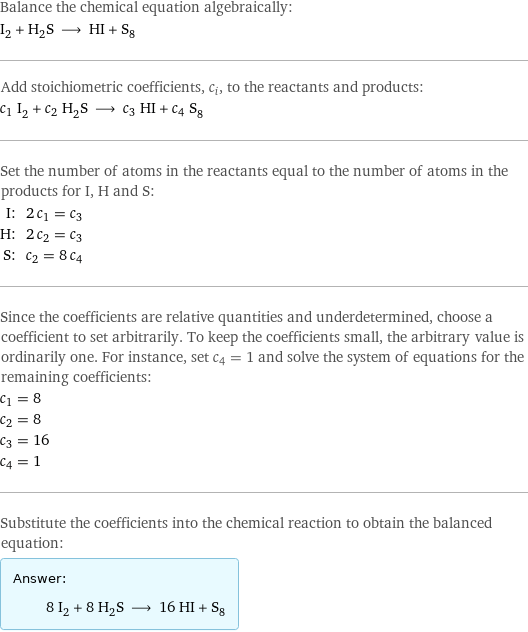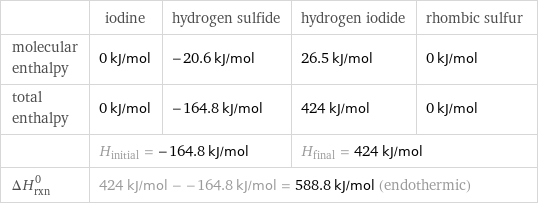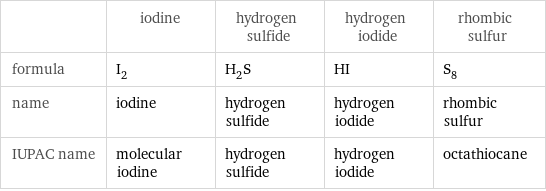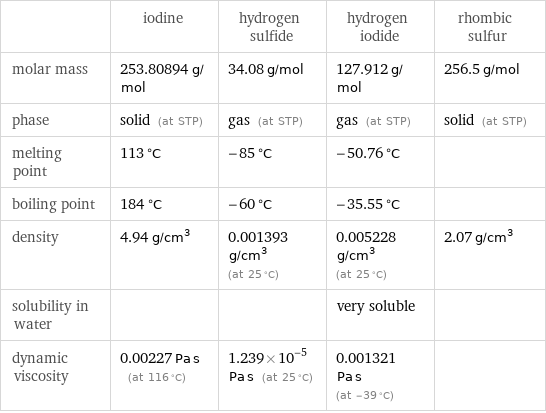Input interpretation

I_2 iodine + H_2S hydrogen sulfide ⟶ HI hydrogen iodide + S_8 rhombic sulfur
Balanced equation

Balance the chemical equation algebraically: I_2 + H_2S ⟶ HI + S_8 Add stoichiometric coefficients, c_i, to the reactants and products: c_1 I_2 + c_2 H_2S ⟶ c_3 HI + c_4 S_8 Set the number of atoms in the reactants equal to the number of atoms in the products for I, H and S: I: | 2 c_1 = c_3 H: | 2 c_2 = c_3 S: | c_2 = 8 c_4 Since the coefficients are relative quantities and underdetermined, choose a coefficient to set arbitrarily. To keep the coefficients small, the arbitrary value is ordinarily one. For instance, set c_4 = 1 and solve the system of equations for the remaining coefficients: c_1 = 8 c_2 = 8 c_3 = 16 c_4 = 1 Substitute the coefficients into the chemical reaction to obtain the balanced equation: Answer: | | 8 I_2 + 8 H_2S ⟶ 16 HI + S_8
Structures

+ ⟶ +
Names

iodine + hydrogen sulfide ⟶ hydrogen iodide + rhombic sulfur
Reaction thermodynamics
Enthalpy

| iodine | hydrogen sulfide | hydrogen iodide | rhombic sulfur molecular enthalpy | 0 kJ/mol | -20.6 kJ/mol | 26.5 kJ/mol | 0 kJ/mol total enthalpy | 0 kJ/mol | -164.8 kJ/mol | 424 kJ/mol | 0 kJ/mol | H_initial = -164.8 kJ/mol | | H_final = 424 kJ/mol | ΔH_rxn^0 | 424 kJ/mol - -164.8 kJ/mol = 588.8 kJ/mol (endothermic) | | |
Equilibrium constant
![Construct the equilibrium constant, K, expression for: I_2 + H_2S ⟶ HI + S_8 Plan: • Balance the chemical equation. • Determine the stoichiometric numbers. • Assemble the activity expression for each chemical species. • Use the activity expressions to build the equilibrium constant expression. Write the balanced chemical equation: 8 I_2 + 8 H_2S ⟶ 16 HI + S_8 Assign stoichiometric numbers, ν_i, using the stoichiometric coefficients, c_i, from the balanced chemical equation in the following manner: ν_i = -c_i for reactants and ν_i = c_i for products: chemical species | c_i | ν_i I_2 | 8 | -8 H_2S | 8 | -8 HI | 16 | 16 S_8 | 1 | 1 Assemble the activity expressions accounting for the state of matter and ν_i: chemical species | c_i | ν_i | activity expression I_2 | 8 | -8 | ([I2])^(-8) H_2S | 8 | -8 | ([H2S])^(-8) HI | 16 | 16 | ([HI])^16 S_8 | 1 | 1 | [S8] The equilibrium constant symbol in the concentration basis is: K_c Mulitply the activity expressions to arrive at the K_c expression: Answer: | | K_c = ([I2])^(-8) ([H2S])^(-8) ([HI])^16 [S8] = (([HI])^16 [S8])/(([I2])^8 ([H2S])^8)](../image_source/e680e2617ddda230e43e74f838a63fe5.png)
Construct the equilibrium constant, K, expression for: I_2 + H_2S ⟶ HI + S_8 Plan: • Balance the chemical equation. • Determine the stoichiometric numbers. • Assemble the activity expression for each chemical species. • Use the activity expressions to build the equilibrium constant expression. Write the balanced chemical equation: 8 I_2 + 8 H_2S ⟶ 16 HI + S_8 Assign stoichiometric numbers, ν_i, using the stoichiometric coefficients, c_i, from the balanced chemical equation in the following manner: ν_i = -c_i for reactants and ν_i = c_i for products: chemical species | c_i | ν_i I_2 | 8 | -8 H_2S | 8 | -8 HI | 16 | 16 S_8 | 1 | 1 Assemble the activity expressions accounting for the state of matter and ν_i: chemical species | c_i | ν_i | activity expression I_2 | 8 | -8 | ([I2])^(-8) H_2S | 8 | -8 | ([H2S])^(-8) HI | 16 | 16 | ([HI])^16 S_8 | 1 | 1 | [S8] The equilibrium constant symbol in the concentration basis is: K_c Mulitply the activity expressions to arrive at the K_c expression: Answer: | | K_c = ([I2])^(-8) ([H2S])^(-8) ([HI])^16 [S8] = (([HI])^16 [S8])/(([I2])^8 ([H2S])^8)
Rate of reaction
![Construct the rate of reaction expression for: I_2 + H_2S ⟶ HI + S_8 Plan: • Balance the chemical equation. • Determine the stoichiometric numbers. • Assemble the rate term for each chemical species. • Write the rate of reaction expression. Write the balanced chemical equation: 8 I_2 + 8 H_2S ⟶ 16 HI + S_8 Assign stoichiometric numbers, ν_i, using the stoichiometric coefficients, c_i, from the balanced chemical equation in the following manner: ν_i = -c_i for reactants and ν_i = c_i for products: chemical species | c_i | ν_i I_2 | 8 | -8 H_2S | 8 | -8 HI | 16 | 16 S_8 | 1 | 1 The rate term for each chemical species, B_i, is 1/ν_i(Δ[B_i])/(Δt) where [B_i] is the amount concentration and t is time: chemical species | c_i | ν_i | rate term I_2 | 8 | -8 | -1/8 (Δ[I2])/(Δt) H_2S | 8 | -8 | -1/8 (Δ[H2S])/(Δt) HI | 16 | 16 | 1/16 (Δ[HI])/(Δt) S_8 | 1 | 1 | (Δ[S8])/(Δt) (for infinitesimal rate of change, replace Δ with d) Set the rate terms equal to each other to arrive at the rate expression: Answer: | | rate = -1/8 (Δ[I2])/(Δt) = -1/8 (Δ[H2S])/(Δt) = 1/16 (Δ[HI])/(Δt) = (Δ[S8])/(Δt) (assuming constant volume and no accumulation of intermediates or side products)](../image_source/08d39d7d2cc47611949c846ca22c5375.png)
Construct the rate of reaction expression for: I_2 + H_2S ⟶ HI + S_8 Plan: • Balance the chemical equation. • Determine the stoichiometric numbers. • Assemble the rate term for each chemical species. • Write the rate of reaction expression. Write the balanced chemical equation: 8 I_2 + 8 H_2S ⟶ 16 HI + S_8 Assign stoichiometric numbers, ν_i, using the stoichiometric coefficients, c_i, from the balanced chemical equation in the following manner: ν_i = -c_i for reactants and ν_i = c_i for products: chemical species | c_i | ν_i I_2 | 8 | -8 H_2S | 8 | -8 HI | 16 | 16 S_8 | 1 | 1 The rate term for each chemical species, B_i, is 1/ν_i(Δ[B_i])/(Δt) where [B_i] is the amount concentration and t is time: chemical species | c_i | ν_i | rate term I_2 | 8 | -8 | -1/8 (Δ[I2])/(Δt) H_2S | 8 | -8 | -1/8 (Δ[H2S])/(Δt) HI | 16 | 16 | 1/16 (Δ[HI])/(Δt) S_8 | 1 | 1 | (Δ[S8])/(Δt) (for infinitesimal rate of change, replace Δ with d) Set the rate terms equal to each other to arrive at the rate expression: Answer: | | rate = -1/8 (Δ[I2])/(Δt) = -1/8 (Δ[H2S])/(Δt) = 1/16 (Δ[HI])/(Δt) = (Δ[S8])/(Δt) (assuming constant volume and no accumulation of intermediates or side products)
Chemical names and formulas

| iodine | hydrogen sulfide | hydrogen iodide | rhombic sulfur formula | I_2 | H_2S | HI | S_8 name | iodine | hydrogen sulfide | hydrogen iodide | rhombic sulfur IUPAC name | molecular iodine | hydrogen sulfide | hydrogen iodide | octathiocane
Substance properties

| iodine | hydrogen sulfide | hydrogen iodide | rhombic sulfur molar mass | 253.80894 g/mol | 34.08 g/mol | 127.912 g/mol | 256.5 g/mol phase | solid (at STP) | gas (at STP) | gas (at STP) | solid (at STP) melting point | 113 °C | -85 °C | -50.76 °C | boiling point | 184 °C | -60 °C | -35.55 °C | density | 4.94 g/cm^3 | 0.001393 g/cm^3 (at 25 °C) | 0.005228 g/cm^3 (at 25 °C) | 2.07 g/cm^3 solubility in water | | | very soluble | dynamic viscosity | 0.00227 Pa s (at 116 °C) | 1.239×10^-5 Pa s (at 25 °C) | 0.001321 Pa s (at -39 °C) |
Units
